Digital versus film photography has been a hot topic of debate for about 10 years. While most professionals have made their decision based on workflow, low light performance, reliability, and running costs, amateurs and fine-art photographers have praised the soul of film and the related process as a way of slowing down and thereby increasing the keeper rate.
For my part, I do not subscribe to this argument, because the shot discipline required by the latest generation of digital cameras (be it the Nikon D800E, the Sony a7r, or the upcoming medium format systems equipped with the Sony 33×44 mm CMOS sensor) leads naturally to a slower process: setting up a sturdy tripod, focusing in live view (contrast detection), mirror lock up and shutter delay, multiple capture for stitching and focus stacking, and “development” of the RAW files.
For the last twenty years I have shot almost exclusively 4×5” sheet film. In these days it was not very dogmatic to accept the fact that view cameras were the tools to achieve ultimate technical quality, at the expense of a very slow process of course. I used Fuji and Kodak slide film in Quickload and Readyload envelopes that allowed me to easily swap material, mark up images for separate development (allowing for corrections by pull and push processes) and avoid any technical error due to light leaks and dust. Albeit its low dynamic range, I preferred slide film because of its fine grain, color rendition, and the ability to compare the final print to the slide displayed on the color-corrected light table. A positive side effect of the large-format photography was that I had invested once into (used) equipment and was done. It was not uncommon, on the other hand, that I spent on the order of 400 $ (US) on film and development to cover one trip.
In recent years I have seen the classical photographic enlargements disappear (and with it my beloved Cibachrome polyester prints), Kodak on Chapter 11, film no more on stock at local stores, and Quickload and Readyload film sheets discontinued. I have gotten film x-rayed to death at security checkpoints, had difficulty in finding a quality lab for film development, and had to send my images across the Atlantic for quality drum-scanning.
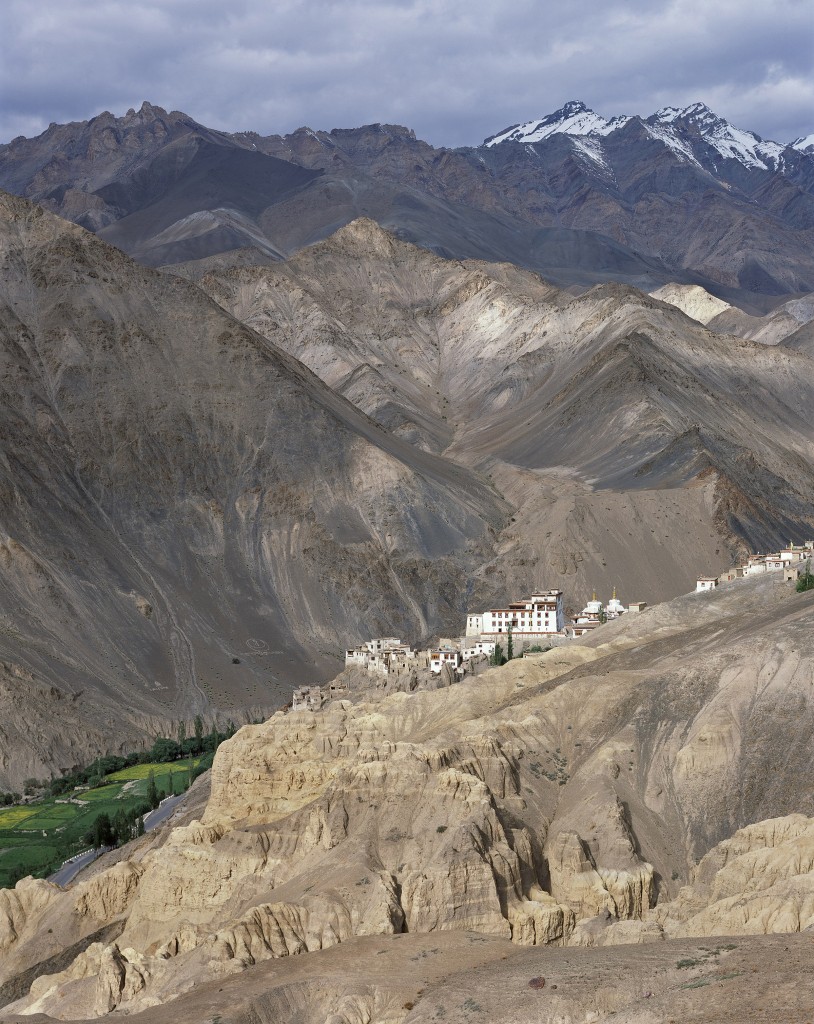
Lamayuru, Ladakh: Linhof Technika 4×5″ with Rodenstock Sironar N 210 mm at f22, Fujichrome Provia 100F
Film (36 mm) was initially estimated to contain an equivalent of 20 million pixels, although this estimate was later revised to as low as 4 MP depending on the type of film. It is save to say that slide film pulls out about 2400 dpi worth of information, which corresponds to 8 Megapixel for 36 mm and an impressive 115 MP for a sheet of 4×5”. This estimate is also in line with the maximum resolution of a Hasselblad Flextight Scanner, which is 2040 dpi for sheet film. One thing is clear though, use the Nikon D800E, stitch two frames together, and it is game over for 36 mm and medium format film, in particular for ISO sensitivities exceeding 400 ASA.
However, perceived image quality is not only about the spatial resolution of film or the pixel count; it is to a large extent related to tonality (color gamut and tonal separation), micro-contrast (details in structures that are close together in luminance), and dynamic range. The dynamic range delivered by the latest generation of sensors outperforms slide film, is about equal to color reversal film and a few stops worse than b&w. It is often said that small-format lenses are better, sharper, and more even in their coverage than large-format lenses, a statement that I will challenge in an upcoming review. I am old enough to remember the debate “does Vinyl sound better than CD” about 30 years ago. So let me present a concrete example, without judgment and without any dogmatic statement.
I took both digital and large-format film cameras to Ladakh and used them side-by-side. Still, it is difficult to match the images, because of the very rapidly changing light there. I could imagine this to make a beautiful time lapse video though. I had very little experience with the D800E at this time because I had received the camera and lenses just one week prior to leaving home. Nevertheless, this example is still one of my bests due to the subtle variations of the tones in the desert landscape, which corresponds well to the skin tones that studio photographers worry so much about.
In order to avoid comments on what I should(n’t) have done and used, let me make a disclaimer: I admit that I used the Nikon 50 mm f1.4 at f11 for a large depth of field. The definitely sharper Nikon 45 mm PC-E tilt/shift lens would have allowed me to use a gentle tilt and thus limit the aperture to f5.6 in order to reduce diffraction. Moreover, the PC-E would have enabled me to stitch two slightly shifted images, thus arriving at the 4×5 aspect ratio without cropping (for an equivalent of 50 MP rather than 30 MP). I did not use it simply because I did not own it at the time.
Fortunately there was very little wind, which is the biggest enemy of the large 4×5 cameras at their usual settings; f16 – f22 at 1/16 – 1/8 of a second. Moreover, the fine-grain Fujichrome 100F could (just) match the scene contrast. The image was scanned on a Hasselblad Flextight Scanner at its maximum resolution of 2040 dpi, which may or may not leave room for improvements. I must run another test to see what is preferable for very large (> 30”) prints: scanning at the resolution limit of the film and uprezzing in Photoshop or oversampling with a high-end drum scanner.
The Nikon image was shot in RAW and processed in Caputure One Pro. The RAW file of the scanned film was directly processed with a plugin for the Hasselblad 3F scanner files. The images where corrected for color and contrast in Photoshop trying to match, as closely as possible, the tonal rendering of the slide film viewed on the light table. The Nikon file was uprezzed in Photoshop to about A1 (590 x 740 mm, 23 x 29″) at 360 ppi, while the scan was down-sampled to the same size. Unsharp mask was then applied to match the pixel acuity of both images. The images below are crops from the above (click to enlarge). Bear in mind that displaying these images on an Apple Thunderbolt screen corresponds to viewing a 76″ (1.9 m) wide print from a one foot (30 cm) distance.
In case of doubt, for the horizontal crops the D800E image is located on the bottom, for the vertical crops the digitals are on the left-hand side and the film scans are on the right.
Had I said earlier that I don’t want to make any judgement, this is because I have not come to a final conclusion myself. Digital has come definitely a long way in the last 10 years in terms of resolution, dynamic range, and color rendition. The instant feedback lets me experiment much more and thus increases my keeper rate, in particular, when dealing with tricky lighting, using fill-in flash, or experimenting with long exposures and motion blur. Still, my most impressive prints in the portfolio are from drum-scanned, 4×5″ film sheets.
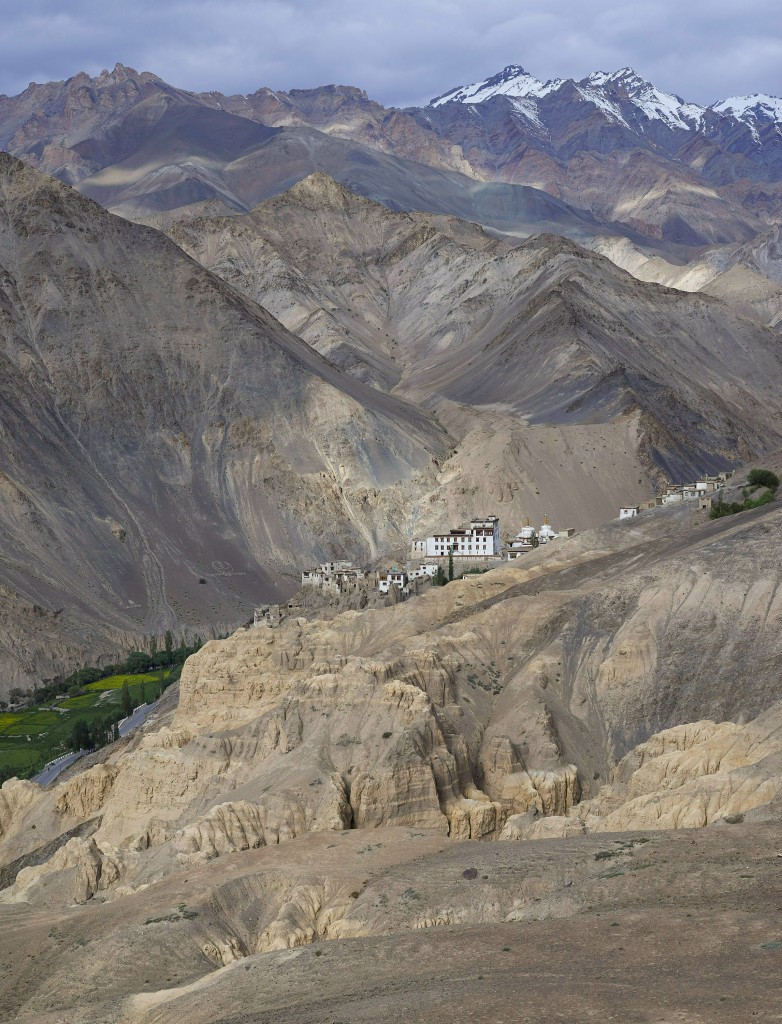
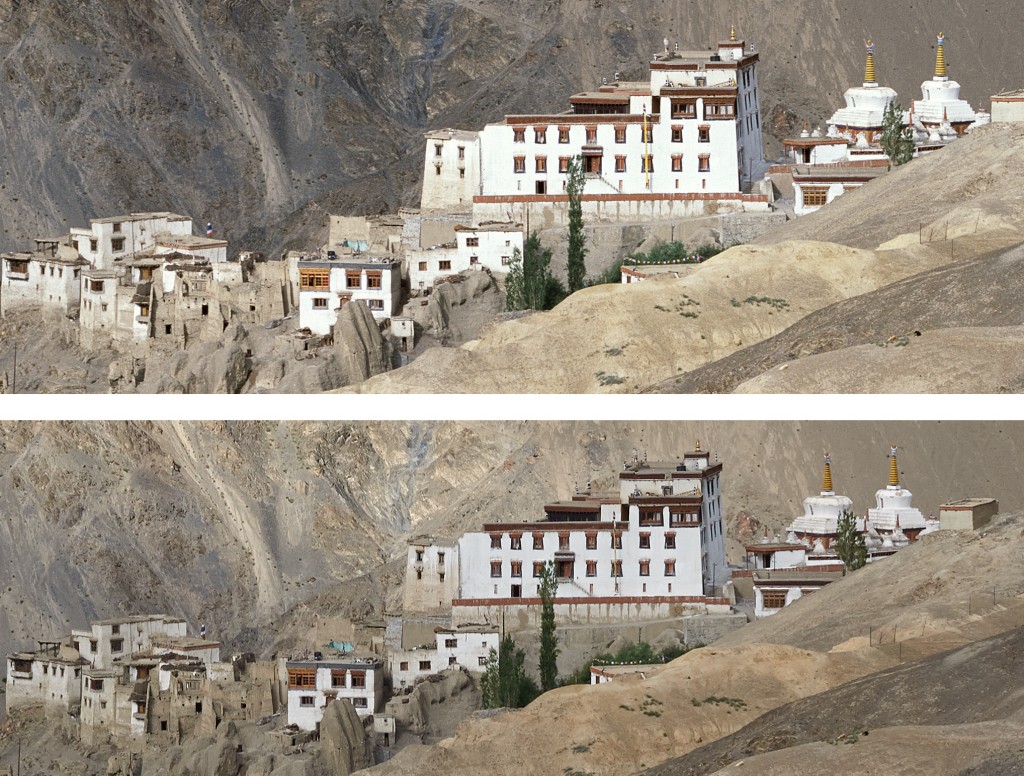
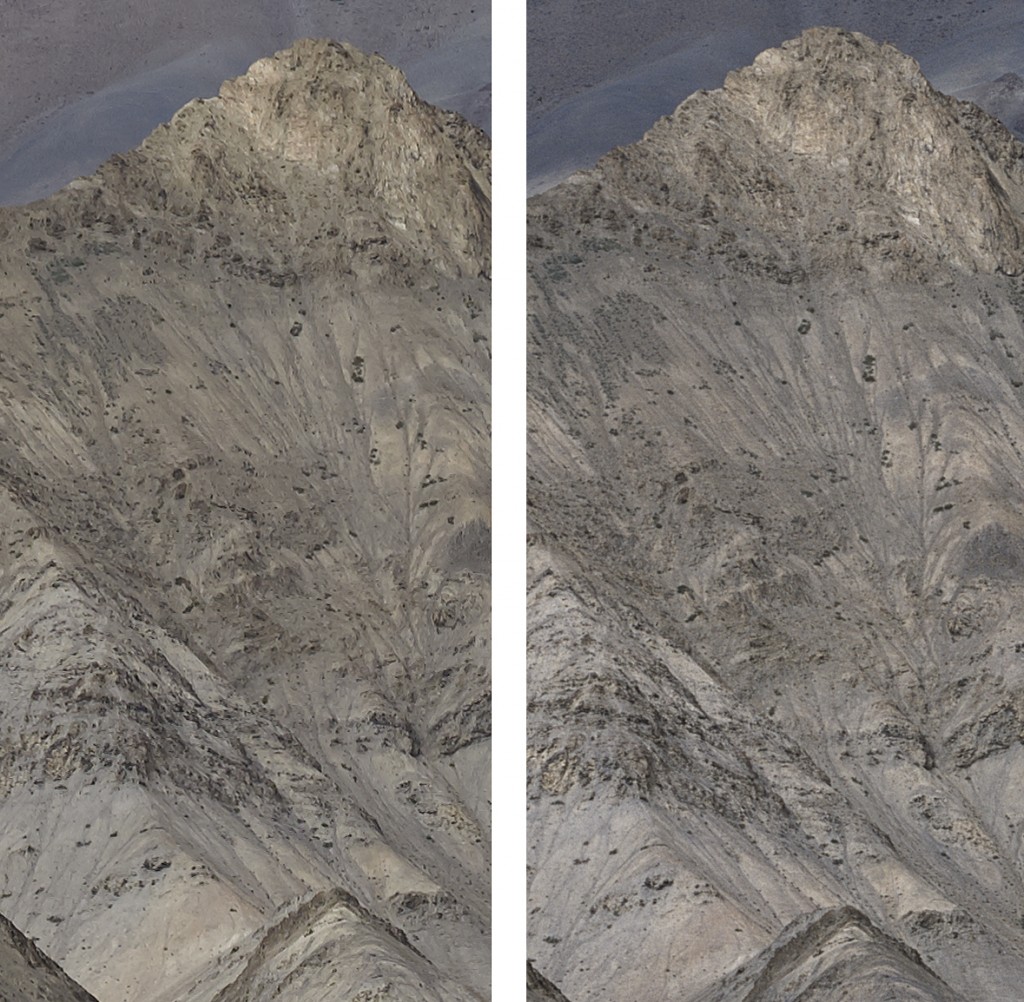
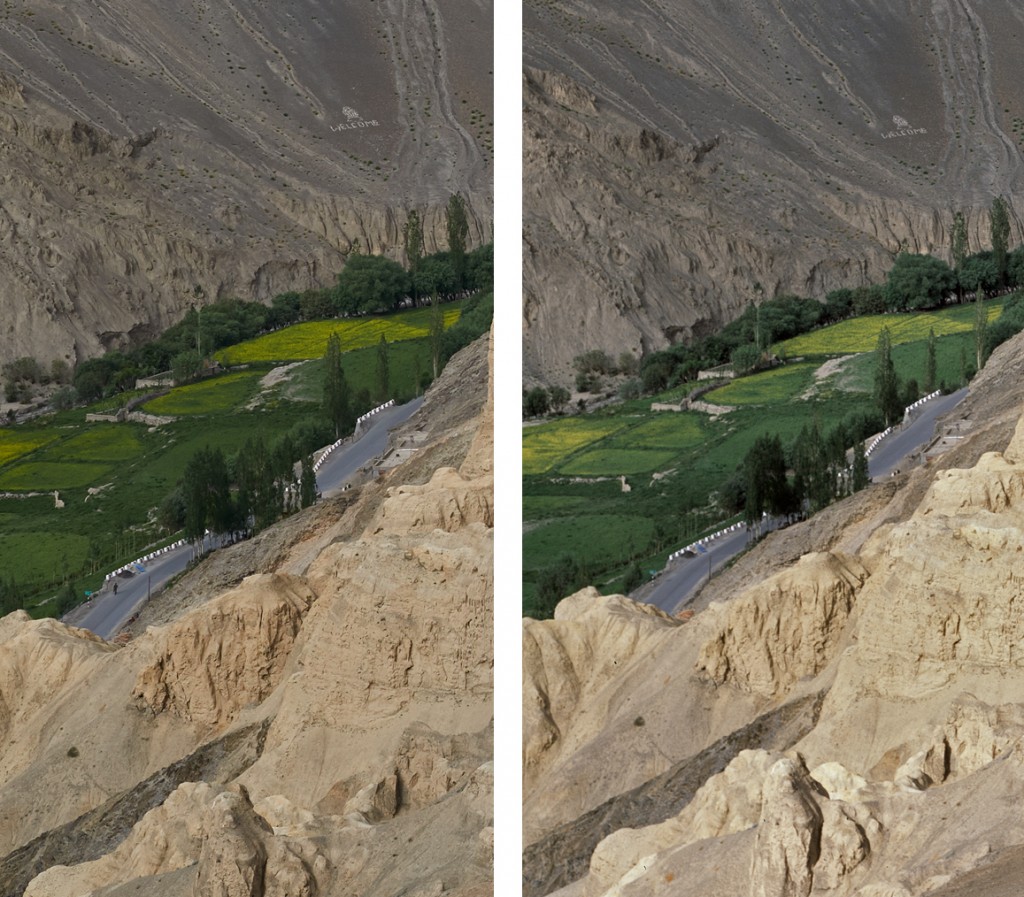
10 Comments
Thank you for the comparison. I can see the difference and it is on favour of 4×5. The scan is more detailed.
But as far as I am concerned the field of view in both images is different. The D800 with 60 mm lens would be adequate rival to 4×5 with 210mm Rodenstock. D800 with 60mm or 70mm (as a mor popular lens) would show a bit more detail in this image. Single shot of D800 in terms of resolution is very close to Mamyia 7.
Of course the resolution is one of the image making aspects. In terms of usability (except resolution and partially architecture) digital cameras are far more better than any film camera. Hoping to see new (affordable) cameras with full, non interpolated colour sensors soon 🙂
Regards & good luck
True, at the time I just had the camera for a few weeks and a limited choice of lenses. Now I would use the 85 mm PC-E and stitch two images together to arrive at the 4×5 aspect ratio.
And there is room for further improvement. As you say, consider a true 16 bit, Foveon type, full-frame sensor paired with an Otus.
Hi Stephan
Excellent, I have not got a favourite in the comparisons, I see a little extra sharpness in the digital when blown up. This is probably due to the 4 x 5 film grain masking some detail. I see a slightly better range of colours on the 4 x 5, which could give the valleys the added depth.
It would be great if there are RAW files, and they were made available, so that they could be worked with by different skill sets to see the end product of a careful editing application.
John
Hi John,
I have no objections against making RAW files available. I must see if/how this can be achieved on the WordPress site (I might have to migrate to Flickr for that purpose). But believe me; the raw files from the Flextight scanner look horrid, which is a concern for color negative film. The slides can still be placed on the light-table, which helps a lot for post-processing.
Stephan
A very good article on the comparison of large format film and 24×36 sensor digital camera results. Not only the results are compared, but also some backgrounds are well highlighted.
Thanks. There is no universal truth to this subject. In the commercial world I keep seeing very graphical, and sometimes almost surreal, renderings of images. In this case the answer is clear; 16-bit medium format is key. I limit my adjustments in Photoshop to dust removal, adjustment of the color temperature and saturation (toward the less flashy side), and some dodging and burning. So the background information on the objectives and desired output are essential.
After reading your article and looking at the pictures in big I am still not sure which one I prefer more. The digital picture looks cleaner and the analog more “organic”. From the point of view of a travel photographer it’s easy. Digital is much simpler- no multiple x-rays, no scratches while developing (as I had it often!!!).
But I still prefer the overall look of the analog scans…….
Thanks for your comments. I like the overall lighting situation a little better in the film image, which of course should not distract us from an objective analysis. The second set of crops shows the larger tonal range and a better micro-contrast in the scanned film. If you know what to look for, the print from the all-digital file looks a bit smudged in places.
As far as convenience is concerned there is of course no discussion. And yes, the scratches: Dust can be spotted out with the Photoshop clone tool, but I had images completely ruined by long, fine scratches and, in particular for color negative film, vertical streaks (light leaks in the developer?) most visible in the dark blue sky.
Probably the best article I ever read that compares film with digital. Well done!
Thanks.